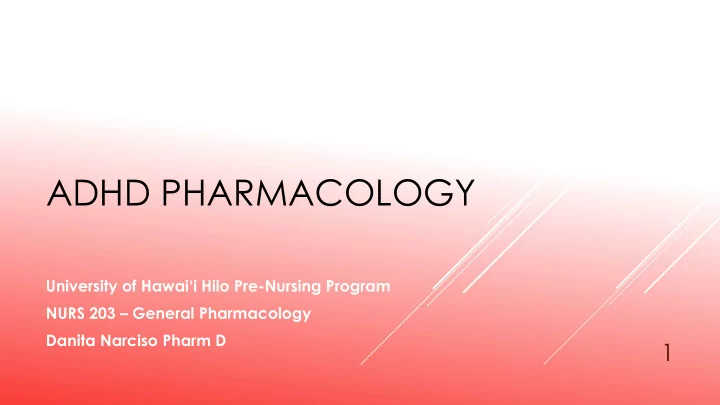

ADHD PHARMACOLOGY University of Hawai‘i Hilo Pre -Nursing Program NURS 203 – General Pharmacology Danita Narciso Pharm D 1
Understand what happens in “filter & gain” under normal circumstances and how that translates to ADHD Understand the pharmacology behind the medications used to treat ADHA Understand the general pharmacologic profiles of the classes of medications used to treat ADHA and the individual characteristics of medications within those classes that give them a niche in therapy LEARNING OBJECTIVES 2
Definition of ADHD Under normal circumstances (filter and gain) Risk factors for ADHD Types of ADHD and diagnosis Medications used to treat ADHD OVERVIEW 3
A persistent pattern of inattention and/or hyperactivity-impulsivity that interferes with functioning or development WHAT IS ADHD? 4
- +/- - + ADHD + Pharmacology 5
- +/- - + ADHD + Pharmacology 6
D1 7 HCN (Funny) Dopamine Potassium Channel
D1 8 HCN (Funny) Dopamine Potassium Channel
- +/- - + ADHD + Pharmacology 9
α2 10 HCN (Funny) Norepinephrine Potassium Channel
Antagonism of the alpha 2 receptor We overwhelmed the alpha 2 receptor Lead to ADHD symptoms Lead to ADHD symptoms α2 α2 FILTER AND GAIN – PROVEN 11 PHARMACOLOGICALLY
Concentration Distraction DA & NE Levels 12 DA & NE Levels DA & NE Levels DA & NE Levels Low Normal High
Concentration ADHD Distraction DA & NE Levels 13 DA & NE Levels DA & NE Levels DA & NE Levels Low Normal High
Family history (inheritable) & psychosocial Temperamental Environmental Course modifiers ADHD – RISK FACTORS 14
Inattention Hyperactivity-Impulsivity HYPERACTIVITY: Fails to give close attention to details, makes careless mistakes Fidgets with hands or feet or squirms in seat Difficulty sustaining attention in tasks Leaves seat in classroom or in other or play situations in which remaining seated is Does not seem to listen when spoken expected to directly Runs about or climbs excessively in situations in which it is inappropriate Does not follow through on Has difficulty playing or engaging in instructions, fails to finish schoolwork, leisure activities quietly chores, or duties Is "on the go" or acts as if "driven by a Difficulty organizing tasks and motor" activities Talks excessively Avoids, dislikes, or is reluctant to IMPULSIVITY: engage in tasks that require sustained Blurts out answers before questions mental effort have been completed Loses things necessary for tasks or Has difficulty awaiting turn activities Interrupts or intrudes on others 15 Easily distracted by extraneous stimuli TYPES OF ADHD Forgetful in daily activities
Stimulants Dextroamphetamine Alpha agonists Methamphetamine Guanfacine (Intuniv) Lisdexamfetamine (Vyvanse) Norepinephrine re-uptake inhibitors Dextroamphetamine + Atomoxetine (Strattera) amphetamine (Adderall) Methylphenidate (Ritalin) Dexmethylphenidate (Focalin) MEDICATIONS USED TO TREAT 16
No outside stimulus is needed to initiate this process! HOW STIMULANTS WORK 17
Dosage form ADRs Oral (XR or IR) Hypertension, insomnia, headache, decreased appetite, dry mouth, Kinetics abdominal pain, arrhythmia Absorption – well absorbed, food Interactions prolongs Tmax CYP2D6 inhibitors, (bupropion & Half life – 9-14 hours depending on fluoxetine), MAOI (CI), CNS age stimulants Metabolism – Liver (CYP2D6) has BBW – Cardiovascular disease & active metabolites abuse potential Time to peak – IR (3 hours), XR (7 Pregnancy – C hours) Excreted in breast milk Excretion – urine (highly dependent on pH of urine, 30-75%) unchanged 18 drug, metabolites (50%) Dextroamphetamine + amphetamine - Adderall
Dosage forms Capsules ADRs Kinetics Insomnia, decreased appetite, dry mouth, upper abdominal pain, Absorption – rapid arrhythmia Distribution – CNS penetration, CSF Interactions concentrations 80% of plasma MAOI (CI), CNS stimulants Metabolism – In the blood, intestines, and liver (no CYP) - Pregnancy – C Prodrug Excreted in breast milk Time to peak – about 1 hour Excretion – 96% in the urine mostly as metabolites 19 LISDEXAMFETAMINE - VYVANSE
Dosage forms Capsules & tablets (XR, chewable, IR), solution & suspension, transdermal patch Kinetics ADRs Absorption – readily absorbed Insomnia, headache, decreased appetite, dry mouth, CV events (different dosage forms vary slightly) Protein binding – low (10-33%) Interactions Metabolism – extensive, into inactive MAOI (CI), Alcohol , CNS stimulants, compounds Pregnancy – C Half life – 2-7 hours, depending on Excreted in breast milk dosage form and age Time to peak – 1-11 hours, depending on dosage form and age Excretion – 90% in urine as metabolites and unchanged drug METHYLPHENIDATE & DEXMETHYLPHENIDATE – RITALIN & 20 FOCALIN – RE-UPTAKE INHIBITOR
Alpha agonists - guanfacine Re-uptake inhibitors - Strattera α2 HOW THE OTHERS WORK - REVIEW 21
Dosage forms Tablet (XR, IR) ADRs Kinetics Somnolence, dizziness, headache, Absorption – Good fatigue, dry mouth, rebound hypertension (d/c) Protein bound – 70% Interactions Metabolism – CYP3A4 CYP3A4 inhibitors, alcohol, other Half life – 10-30 hours hypertensive medications, Time to peak – 2.6-5 hours Pregnancy – B Excretion - 50% in urine as Not known if excreted in breast milk unchanged drug 22 GUANFACINE – INTUNIV & TENEX
Dosage forms Capsule ADRs Kinetics Somnolence/insomnia , headache, dry mouth, decreased appetite Absorption – rapid Interactions Protein bound – 98% CYP2D6 inhibitors, MAOIs (CI), Metabolism – CYP2D6 (poor mifepristone, (QTc prolongation) metabolizers) & 2C19 Pregnancy – C Half life – 5 hours (parent), 6-8 (metabolite) Not known if excreted in breast milk Time to peak – 1-2 hours (delayed by fatty meal) Excretion – Urine, mostly as metabolites, 17 % in feces 23 ATOMOXETINE - STRATTERA
QUESTIONS 24
Recommend
More recommend